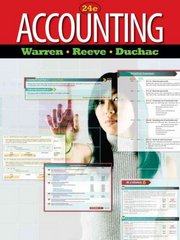Question
This assignment is a continuation of the Cookie Creations case study, which began in Chapter 1. From the information gathered in the previous chapter, read
This assignment is a continuation of the Cookie Creations case study, which began in Chapter 1. From the information gathered in the previous chapter, read the continuation of the Cookie Creations case study in Chapter 2 of the textbook on p. 2-42.
The case study allows you to apply what you have learned about accounting and the recording process. This assignment will enable you to practice what you have learned so far.
After researching the different forms of business organization, Natalie decides to operate Cookie Creations as a proprietorship. She then starts the process of getting the business running. In November 2019, the following activities listed below take place.
Nov. 8: Natalie cashes her U.S. Savings Bonds and receives $520, which she deposits in her personal bank account.
Nov. 8: She opens a bank account under the name "Cookie Creations" and transfers $500 from her personal account to the new account.
Nov. 11: Natalie pays $65 for advertising.
Nov. 13: She buys baking supplies, such as flour, sugar, butter, and chocolate chips, for $125 cash. (Hint: Use the Supplies account.)
Nov. 14: Natalie starts to gather some baking equipment to take with her when teaching the cookie classes. She has an excellent top-of-the-line food processor and mixer that originally cost her $750. Natalie decides to start using it only in her new business. She estimates that the equipment is currently worth $300. She invests the equipment in the business.
Nov. 16: Natalie realizes that her initial cash investment is not enough. Her grandmother lends her $2,000 cash, for which Natalie signs a note payable in the name of the business. Natalie deposits the money in the business bank account. (Hint: The note does not have to be repaid for 24 months. As a result, the note payable should be reported in the accounts as the last liability and on the balance sheet as the last liability.)
Nov. 17: She buys more baking equipment for $900 cash.
Nov. 20: She teaches her first class and collects $125 cash.
Nov. 25: Natalie books a second class for December 4 for $150. She receives $30 cash in advance as a down payment.
Nov. 30: Natalie pays $1,320 for a 1-year insurance policy that will expire on December 1, 2020.
Answer the questions below using an Excel spreadsheet. You should have new tab on your spreadsheet for each calculation used for a total of three tabs on your spreadsheet.
- Prepare journal entries to record the November transactions.
- Post the journal entries to general ledger accounts.
- Create trial balance at November 30.
Step by Step Solution
There are 3 Steps involved in it
Step: 1

Get Instant Access to Expert-Tailored Solutions
See step-by-step solutions with expert insights and AI powered tools for academic success
Step: 2

Step: 3

Ace Your Homework with AI
Get the answers you need in no time with our AI-driven, step-by-step assistance
Get Started


